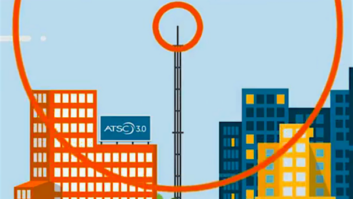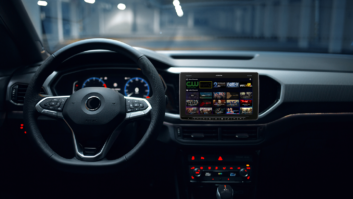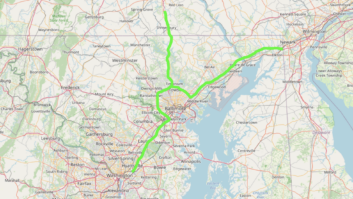Field Report: Adobe Audition 3.0
Feb 1, 2008 12:00 PM, By Chris Wygal

The old adage “you get what you pay for,” is for the most part true. However, this saying is de-bunked by Adobe Audition 3, released in November 2007. Without a doubt, the new software suite gives five-figure production results at a three-figure price (less than $400). Plus, it doesn’t require an over-achieving audiophile!
A little history
Most folks in the radio industry know something about Cool Edit Pro. Cool Edit was originally developed by Syntrillium in the 1990s, offering affordable and flexible desktop audio editing. In 2003, Adobe acquired Syntrillium and replaced Cool Edit Pro with Audition 1.5, essentially adding the spectral display. Later, Audition 2.0 gave users an overhauled mixing engine with the added features of sends and buses, putting studio routing techniques on-screen. Now, Audition 3 includes a MIDI sequencer, added editing efficiencies and spectral tools that are a bigger part of the audio crafting arsenal.
What it looks like
Audition 3 is primarily divided into three views: waveform editing, CD and multitrack. Waveform edit view uses a destructive method when editing files. For example, if reverb effects are applied and saved, the file is permanently changed. Waveform edit view is handy when recording a simple voice-over clip. Multitrack view on the other hand, displays multiple tracks and file changes are non-destructive, allowing for increased flexibility. Multitrack view is used to include music beds and sound effects, for example, with a voice track. Sends and buses route effects and other processes in real-time using VST (Virtual Studio Technology) and familiar multitracking techniques like punching in are available. Audition 3’s dockable panels, such as the time display, transport buttons and zoom controls make all user-defined displays available on screen. Both edit view and multitrack view have their own dockable panels, depending on which features the user wishes to have open. CD View provides a handy interface for assembling and burning CDs.
A major accomplishment of Audition 3 is the simulation of familiar studio recording techniques. Most sound engineers are accustomed to patching and recording equipment. Audition 3 puts the entire studio on the screens (a dual-monitor configuration is highly suggested). In conjunction with the VST effects, sends, buses and channel strips are loaded onto the mixer panel in multitrack view. The channel strip is similar to a channel strip on a standard mixing console.
Making it easier
New users to Audition 3 will notice a very intuitive layout. The goal in Audition 3’s development was to achieve a more efficient workflow. For example, since most envelope editing only creates fades and crossfades, Audition 3 has introduced dedicated fade handles in addition to the traditional volume envelopes, to quickly apply a fade to a single track, or automatically crossfade between two clips in multitrack view. Top/Tail view, (in the waveform edit view) only displays the first and last 10 seconds of a clip. This is useful when working on intros and outros.

Adobe Audition 3 has a very intuitive layout.
The Save All Audio As function allows the user to save multiple files into the same destination folder, using the same naming template and file format in one step. This feature is perfect at the end of a session when several unsaved files need to be collected, using a specific naming strategy, into one common folder. Audition 3 also makes extracting or ripping audio from CDs a snap, eliminating the need to real-time CD material. ID3 v.1 tagging is supported when creating CDs, so metadata such as artist, album, year and genre will appear on other media players.
Compression and acoustic effects are popular processes in radio production. After working with non-linear software for an extended period of time, the engineer picks his favorite processes and docking preferences. The Favorites tab allows the user to insert his most commonly used tasks, and then give the tasks a friendly name. Also, currently open files, favorites and Audition’s onslaught of effects are examples of the tabs found in a dockable panel next to the audio file timeline workspace. In the workspace menu, several pre-defined options allow the user to optimize his desktop, specific to his task.
Field Report: Adobe Audition 3.0
Feb 1, 2008 12:00 PM, By Chris Wygal
Performance at a glance Improved editing features
Supports VST effects plug-ins
VST Izotope plug-in package
Loopology music library
New MIDI sequencer
Making it sound great
The creative possibilities stuffed into Audition 3 are endless. First, Audition boasts a complement of tools that allow for cleaning up and restoring audio. When digitizing old cassettes or reels, frequency specific Automatic Phase Correction effects are available to quickly correct azimuth problems. The Adaptive Noise Reduction filter allows for extra-critical elimination of unwanted noises that occur in a poor recording. This filter will find noise within the audio track, without the user’s having to sample a segment of noise, which is sometimes impossible. Plus, if for example a ground loop buzz changes in frequency over the length of the audio clip, the Adaptive Noise Reduction filter will change, thus continually eliminating the noise.
Secondly, with the help of Izotope, Audition 3 is armed with a near infinite list of effects. For example, Audition 3 has introduced a multi-band compressor from Izotope in addition to the traditional dynamics compressor (both VST). The Mastering Tool, also VST, makes difficult mastering techniques easy. It is equipped with presets that allow for adjustment of the final mastering EQ, exciter, tube, reverb, Loudness Maximizer and stereo image widener. Izotope also delivers a time stretch feature, which transparently changes the pitch and/or tempo of an audio clip, and a tube-modeled compressor that replicates classic compressor techniques, and comes with plenty of presets.
Thirdly, Audition 3 supports multi-core technology. Dividing real-time effects across several processors reduces glitches and bugs, thus increasing productivity. In addition to multi-core processing, dual-monitor technology will help productivity as well. Two monitors not only give the user more desktop space, but more importantly, a quality dual-monitor video card usually handles the video processing, which lightens the CPU processing load.
The big bang theory
There are two groups of audio professionals we’ve failed to mention: the radio production folks who produce their own music, and the audio perfectionists who hear absolutely everything. For the music people, Audition 3 is bundled with Loopology, an extensive set of layered loops in different tempos and keys. These loops can be combined to create original sounding ads and imaging bed masterpieces. A new MIDI sequencer is also available, making music creation possibilities endless.
Next, are the type-A sound engineers. When in waveform editing view, switching the file to spectral display allows the user to physically change the waveform by seeing audio anomalies that aren’t visible in the standard green waveform display. Harmonics, frequency-specific phasing problems, and other oddities can be edited using the spectral display. A healing brush and lasso tool allow the user to change the way the waveform looks, in order to change its sound. The waveform, in spectral display, can be exported as a BMP file to Adobe Photoshop, edited, and then imported back into Audition 3. Using this technique, the user can see the sound and edit accordingly.
Adobe P
W
800-833-6687
www.adobe.com
Obviously, Audition 3 is far from lacking when it comes to creating top-quality audio. Whether a musician, voice-over artist or radio producer, Audition 3 is pushing the envelope by expanding creative possibilities, making affordable features efficient and available.
Wygal is the programmer, engineer and Web designer for WRVL in Lynchburg, VA.












